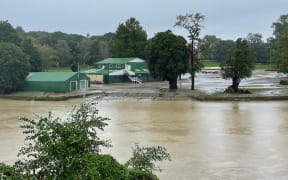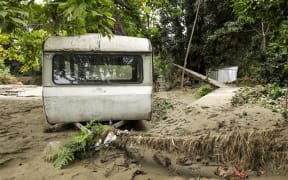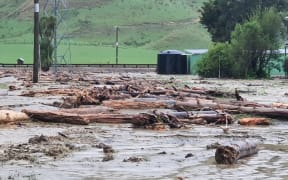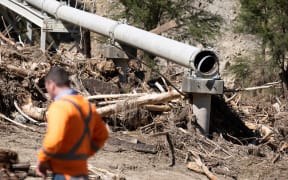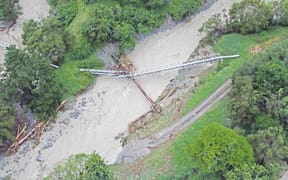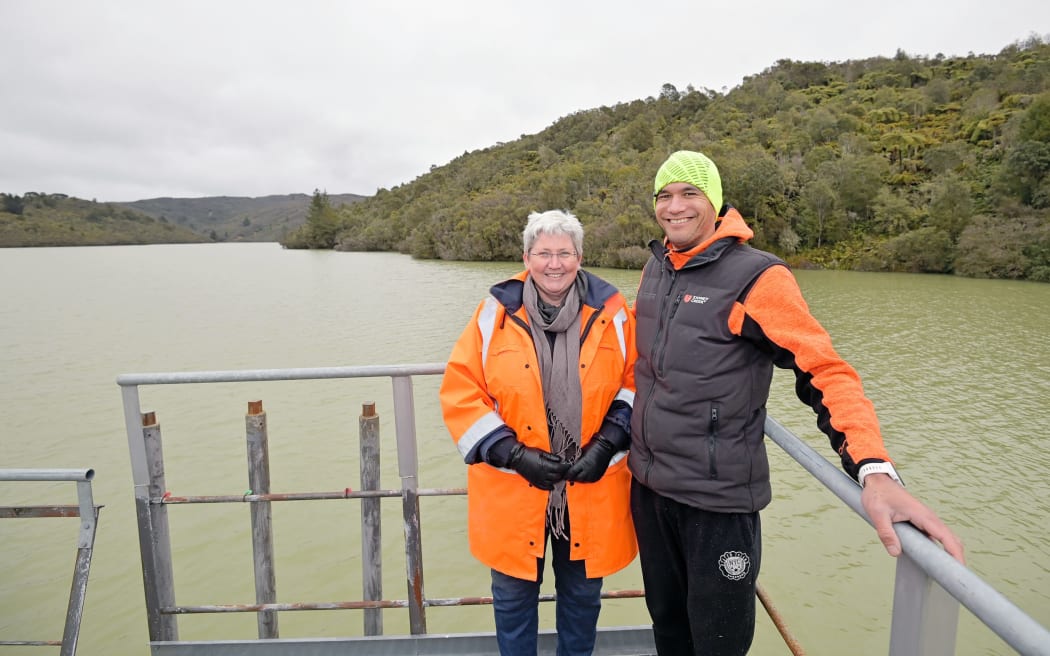
Gisborne District Council drinking water manager Judith Robertson and treatment plant operator Anton Gage at the Mangapoike dams. Photo: LDR / Gisborne Herald / Liam Clayton
With summer just around the corner and a very real threat of drought from an El Nino weather system looming, Gisborne District Council is in a race against time to make important upgrades to its water network. Matthew Rosenberg took a look behind the scenes at the city's vulnerable supply.
Like a snake it weaves its way through the rugged countryside. Crossing rivers and traversing forests, it disappears into hillsides, twists around corners and dances its way through the landscape.
Gisborne District Council's 40km water pipeline has a long and precarious journey from the three dams it draws on in backcountry Tai Rāwhiti, to the homes and businesses it services in the city below.
But it is an important journey, and one which must be made for the 40,000 people who rely on its delivery.
"It's always stressful with water. It's always in high demand," council healthy living team lead Judith Robertson says from the front seat of an off-road buggy.
Robertson is en route to the three dams which provide the bulk of Gisborne's water supply, 40km southwest of Gisborne.
Her counterpart - water treatment plant operator Anton Gage - is behind the wheel, manning a walkie talkie and making sure the buggy doesn't have an unfortunate encounter with one of the many logging trucks in the area.
"I can't stress enough, this is where Gisborne's water supply comes from. This is where the rain falls, so that's why the dams are here," Robertson says, giving a nod to the precarious, saturated hillsides which surround her.
When Cyclone Gabrielle swept through Tai Rāwhiti, it was kind to neither Waingāke nor the pipeline.
The photos were startling - whole logs surrounding splintered infrastructure; the once-blue waters of the local dams turned a muddy brown.

Damage to the city's main water pipeline captured soon after Cyclone Gabrielle. Nine of a total 21 bridges carrying the water pipe were damaged in the event. Photo: Supplied via LDR
Nine of a total 21 bridges carrying the water pipe were damaged, leaving council staff with a monumental task ahead of them.
It was 84 days before all water restrictions were fully lifted, on 8 May.
Six months on from the cyclone, the council isn't out of the woods yet. While it is no longer in crisis mode, it's having to work at pace to address the next problem: getting ready for summer with a compromised network.
Robertson is surprisingly relaxed for someone in charge of such an important system, particularly one that was so badly damaged earlier this year.
She's a wealth of knowledge on all things water, and talks ceaselessly on the subject.
"The thing to keep in mind is the dams provide 70 percent of Gisborne's [annual] water supply," Robertson says.
"And in summer, it's practically 100 percent because rivers are too low."
Those dams - referred to collectively as the Mangapoike dams - consist of three separate lakes: Williams, Clapcott and Sang.
Since the cyclone, the output from the collective has been reduced to a "trickle", by Robertson's own admission.
As little as 10 percent of Gisborne's water supply is coming from the Mangapoike dams, with only Clapcott's water usable.
Even then it must be blended with the cleaner offerings of Te Arai River, referred to by the council as the Bush catchment.
Looking down on the three lakes from a vantage point called Wayne's Track, some 500 metres above sea level, Sang looks to have escaped the slips which have muddied the quality of its counterparts.
There's one problem standing in the path of that water being used: a lack of direct piping to the Waingake Treatment Plant.
Sang dam's water is only usable through a valve system connected to the adjacent Clapcott, but emptying into the latter under current conditions would be a waste, like mixing good apples with bad.
All of that is about to change, Robertson explains.
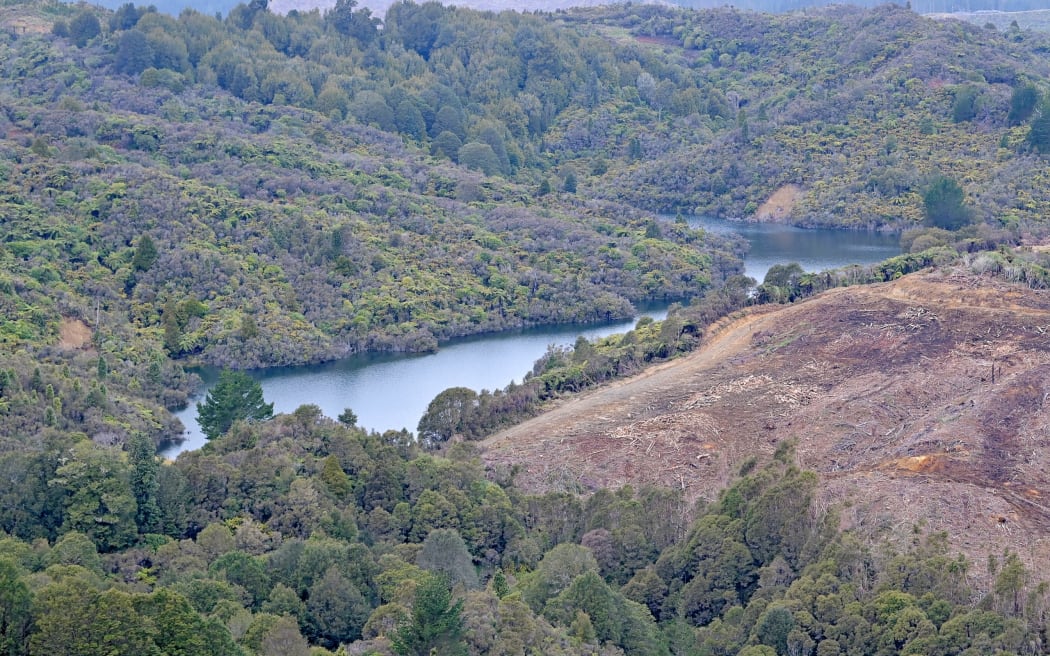
Sang dam is the only one of the three Mangapoike dams which made it through the cyclone unscathed. A new project will pipe water directly from that dam to the Waingake Treatment Plant in the coming months. Photo: LDR / Gisborne Herald / Liam Clayton
A new $587,000 project will soon connect the Sang dam to Waingake Treatment Plant (located about 10km from the dams), meaning its water will be directly accessible for the first time.
The treatment plant, constructed with government funding on the back of Cyclone Bola in 1988, will also undergo $5.5 million of upgrades.
These will be significant, Robertson says, because they will also allow the council to treat an increased supply of dirty water out of Clapcott and Williams.
And that can't happen soon enough, with summer just around the corner and a fast-developing El Nino weather system raising the spectre of drought on the East Coast.
"The thing about this is it only gets us back to what we were [doing] before the cyclone. Before the cyclone, we had clean dam water.
"It's going to be OK; we're going to have this treatment phase done. We're going to be able to use this water over summer."
In an upstairs control room at the treatment plant, drinking water operator Paora Te Rangiita monitors levels on a series of screens.
At the top of one it reads "Current city demand", with an ever-changing number displayed next to it.
On a cool Thursday morning in Gisborne, the live total sits at around 570,000 litres an hour, the equivalent of approximately 20 Fonterra tankers.
In summer, it could nearly double to over one million litres an hour.
Fortunately it isn't just the blended water from Mangapoike dam and Te Arai River water that the city is currently relying on.
Around 50 percent of Gisborne's supply is from the Waipaoa Treatment Plant at present, which draws on the river of the same name.
In summer, the council's use of river water is limited to protect them from running dry, which is why it's working extra hard in the winter months to get the dam supply usable for the predicted spike.
Robertson is optimistic the water situation will return to a semblance of normality this summer.
The elephant in the room remains the fragility of the network.
The council has a long history in the area, having piped water out of Te Arai River since 1909, and Robertson defends the location of the infrastructure due to the rainfall there.
"That's why the dams are here."
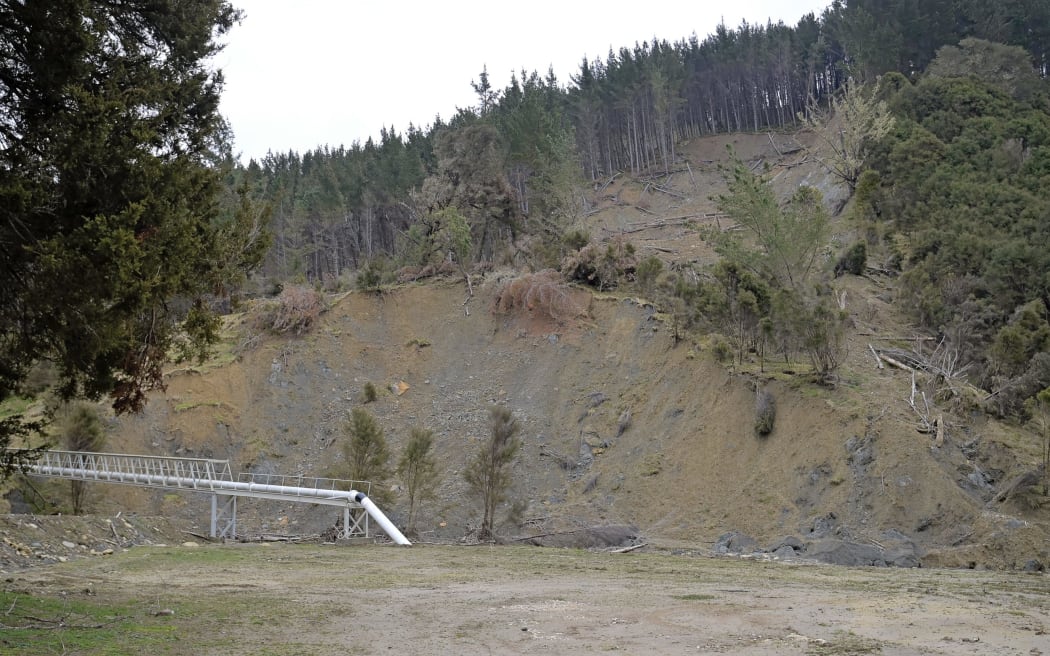
Industry is still alive and well in Waingake, with forestry work powering ahead on the surrounding hills. Loose logs and slash could be seen lining the hillside above a section of pipe bridge which was damaged during Cyclone Gabrielle. Photo: LDR / Gisborne Herald / Liam Clayton
But on the day Local Democracy Reporting visited, the wheels of industry were turning at pace in the hills, leaving a graveyard of woody debris in its wake, on fragile land.
Forestry remains a contentious topic in Tai Rāwhiti, with the fallout from Cyclone Gabrielle leaving a legacy of waste in the region never before seen on that scale.
Slash and whole logs left behind by logging companies on erosion-prone land were picked up by floodwaters, acting as bulldozers as they hurtled down waterways.
Although now repaired, Gisborne's main water supply continues to run the gauntlet through a narrow 525mm diameter pipe over unstable land which is either home to pine, or adjacent to it.
Much of the land it passes through at Waingake is council-owned, and the organisation is working to regenerate large sections into native bush as part of a 30-plus year project.
In 1991, the council bought a large parcel from Maraetaha Incorporated, establishing a plantation pine forest under a joint forestry agreement.
Once staged harvesting of that plantation is complete by 2027, the council plans to transform 1200 hectares back into native forest, which it hopes will secure the pipeline into the future.
Juken New Zealand (JNL) is the consent holder for the land, and says it was not responsible for the damage sustained during Cyclone Gabrielle.
"No current harvesting contributed to the water pipeline damage from JNL operations," executive manager Dave Hilliard said following the event.
He also believed the majority of debris would have been caught by standing trees which were deliberately left between the harvest area and the pipeline.
Before departing in August, former council director community lifelines Dave Wilson said there was nothing more the council could have done to protect the pipeline under current funding constraints.
Meanwhile, Robertson says the network's vulnerability is not a new problem.
"This is not a forestry issue, this is a terrain issue and storm issue.
"It has always had vulnerabilities and it will continue to have vulnerabilities, because of terrain."
Robertson looks forward to the day the area is a blooming native forest, but concedes that could be decades away.
Until then, it seems a high level of trust is required for the sustained future of Gisborne's brave little
pipeline.
And a hope that as the sediment settles in the dams over coming years, so does the extreme weather which has been plaguing the region.
Local Democracy Reporting is Public Interest Journalism funded through NZ On Air
